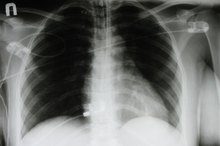What does fact checked mean?
At Healthfully, we strive to deliver objective content that is accurate and up-to-date. Our team periodically reviews articles in order to ensure content quality. The sources cited below consist of evidence from peer-reviewed journals, prominent medical organizations, academic associations, and government data.
- FamilyDoctor.org: Exercise-Induced Braonchospasm - What You Should Know
- Cleveland Clinic: Symptoms of Asthma
- MayoClinic.com: Asthma - Symptoms
The information contained on this site is for informational purposes only, and should not be used as a substitute for the advice of a professional health care provider. Please check with the appropriate physician regarding health questions and concerns. Although we strive to deliver accurate and up-to-date information, no guarantee to that effect is made.
Bronchospasm Symptoms
Bronchospasm is a term used to describe the unusual narrowing or constriction of the airways. The symptoms of bronchospasm typically mimic those of asthma, a chronic lung disease, though people who don't have asthma can experience bronchospasm 12. Mild bronchospasm symptoms may resolve without additional medical intervention, but severe bronchospasm symptoms require emergency medical care.
If you are experiencing serious medical symptoms, seek emergency treatment immediately.
Wheezing
In healthy people, air flows freely into the lungs when they inhale. During bronchospasm, this inhaled air has a difficult time flowing through a person's narrowed airways. As the air squeezes through the tightened airway, it can make a squeaking or whistling sound, a bronchospasm symptom called wheezing, the American Academy of Family Physicians sponsored website FamilyDoctor.org explains. Wheezing typically occurs during inhalation and may be audible to other people who are near a person experiencing bronchospasm.
- In healthy people, air flows freely into the lungs when they inhale.
- During bronchospasm, this inhaled air has a difficult time flowing through a person's narrowed airways.
Chest Pain or Tightness
Heart Flutters Symptoms
Learn More
When the airways constrict during a bronchospasm, people may experience sensations of pain, pressure or tightness in the chest, the Cleveland Clinic reports 1. Chest discomfort may be more severe when the lungs expand during inhalation and can exacerbate breathing difficulties. People who experience sudden or severe chest pain should seek immediate medical care, as this symptom of a bronchospasm attack is also a sign of a heart attack.
Breathing Difficulties or Coughing
People who experience a bronchospasm attack may develop mild to severe breathing difficulties, depending upon the extent of airway constriction. Extensive airway constriction can cause sudden shortness of breath, a bronchospasm symptom that requires emergency medical care, MayoClinic.com advises 2. Airway irritation caused by bronchospasm may also lead to symptoms of a recurrent or persistent cough. Frequent coughing can exacerbate chest pain or discomfort symptoms in people who experience bronchospasm.
- People who experience a bronchospasm attack may develop mild to severe breathing difficulties, depending upon the extent of airway constriction.
- Frequent coughing can exacerbate chest pain or discomfort symptoms in people who experience bronchospasm.
Related Articles
References
- Cleveland Clinic: Symptoms of Asthma
- MayoClinic.com: Asthma - Symptoms
- American Academy of Allergy Asthma and Immunology: Diseases 101 - Asthma
- National Heart Lung Blood Institute: What is Asthma
- Fredberg JJ. Bronchospasm and its biophysical basis in airway smooth muscle. Respir Res. 2004;5:2. doi:10.1186/1465-9921-5-2
- Molis MA, Molis WE. Exercise-induced bronchospasm. Sports Health. 2010;2(4):311-7. doi:10.1177/1941738110373735
- Myatt R. Pulse oximetry: what the nurse needs to know. Nurs Stand. 2017;31(31):42-45. doi:10.7748/ns.2017.e9940
- Sood P, Paul G, Puri S. Interpretation of arterial blood gas. Indian J Crit Care Med. 2010;14(2):57-64. doi:10.4103/0972-5229.68215
- Eltzschig HK, Carmeliet P. Hypoxia and inflammation. N Engl J Med. 2011;364(7):656-65. doi:10.1056/NEJMra0910283
- Agarwal D, Gupta PP, Sood S. Assessment for Efficacy of Additional Breathing Exercises Over Improvement in Health Impairment Due to Asthma Assessed using St. George's Respiratory Questionnaire. Int J Yoga. 2017;10(3):145-151. doi:10.4103/0973-6131.213472
- Mchugh P, Aitcheson F, Duncan B, Houghton F. Buteyko Breathing Technique for asthma: an effective intervention. N Z Med J. 2003;116(1187):U710. PMID:14752538
- Fitzgerald MA. Managing Bronchospasm with Short-Acting Beta2-Agonists. Nurse Pract. 2006 Sep; 31(9):47-53.
- Hall C, Nici L, Sood S, ZuWallack R & Castro M. Nonpharmacologic Therapy for Severe Persistent Asthma. J Allergy Clin Immunol Pract 2017 Jul - Aug; 5(4):928-935. DOI: 10.1016/j.jaip.2017.04.030.
- Kodadek LM & Lipsett PA. Respiratory Complications. In Sidawy, AN & Perlor BA, Rutherford's Vascular Surgery and Endovascular Therapy, 9th. ed. Elsevier, Philadephia:PA. 2019.
- Patient Education: Bronchospasm, Adult. Clinical Key website. Updated June 27, 2018.
Writer Bio
Rae Uddin has worked as a freelance writer and editor since 2004. She specializes in scientific journalism and medical and technical writing. Her work has appeared in various online publications. Uddin earned her Master of Science in integrated biomedical sciences with an emphasis in molecular and cellular biochemistry from the University of Kentucky College of Medicine.








